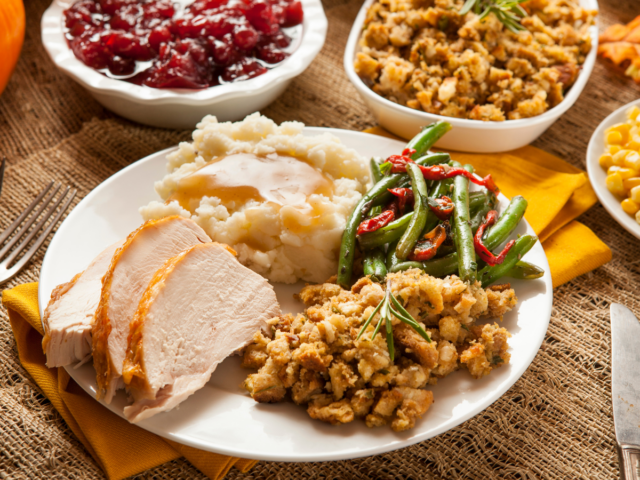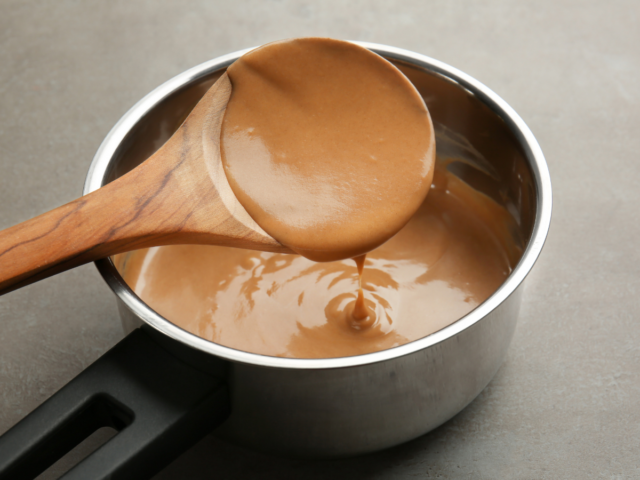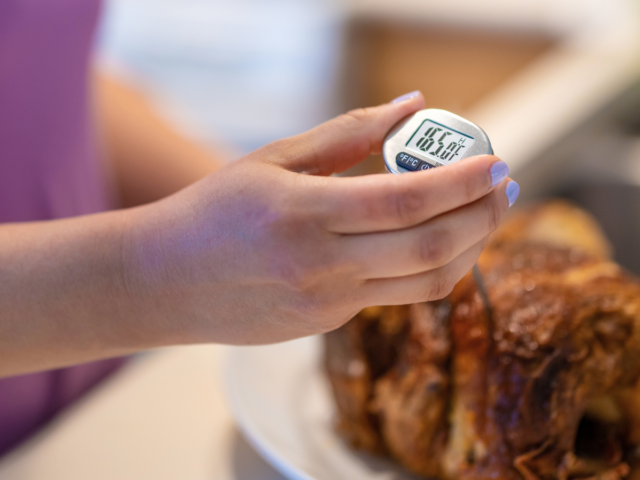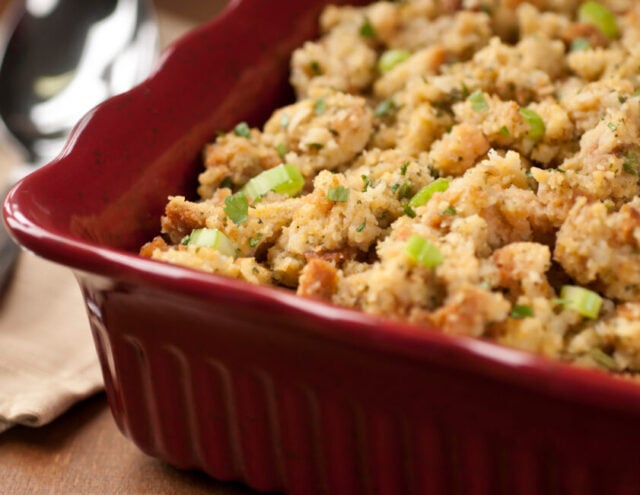[ad_1]
Thanksgiving leftovers can be delicious… if you know how to reheat them the right way. Whether it’s leftover turkey, creamy mashed potatoes, or sweet potato casserole, reheating your Thanksgiving food properly will keep the flavors at their best and ensure it’s safe to eat. Let’s break down the best way to handle each dish.

Store and Reheat Properly
Make sure your leftovers remain at their best quality starting with proper storage. Place leftovers in shallow containers or an airtight container with as little air as possible inside to allow for even cooling and minimal spoilage bacteria growth. Once stored, your leftovers should be reheated to a safe temperature of 165 degrees F to keep them out of the danger zone where bacteria thrive.
Tools for Reheating Leftovers
Depending on what you have, different tools can help make your leftovers taste freshly made:
- Oven or Countertop Oven: For even heating of dishes like stuffing or turkey.
- Microwave: Quick and effective for smaller portions or single servings.
- Slow Cooker: Great for reheating moist dishes like stews, allowing flavors to meld with a little added broth.
- Air Fryer: Ideal for getting crispy textures back, like on roasted vegetables or crispy skin on turkey.

How to Reheat Thanksgiving Leftovers, Dish by Dish
Leftover Turkey
Reheating leftover turkey can be tricky, as the lean meat can dry out if not reheated with care. To bring back the moisture:
- Oven: For whole turkey portions or larger cuts, place the turkey in a baking dish or roasting pan with a small amount of turkey stock or chicken broth to keep it juicy. Cover with aluminum foil to let it steam gently and heat at low heat (around 300°F) until it reaches an internal temperature of 165°F.
- Stovetop: If you’re working with smaller portions like slices of turkey, add a splash of broth to a skillet over medium heat, cover, and stir occasionally to ensure even heating.
- Microwave: This works best with cold turkey sliced into small pieces. Place it on a microwave-safe plate, cover with a damp paper towel to prevent drying, and reheat in short bursts, stirring in between to avoid cold spots.
Stuffing and Casseroles
Whether it’s stuffing, green bean casserole, or a turkey pot pie, these Thanksgiving sides can be warmed in the oven.
- Oven: Use a baking dish or ceramic dish and cover with foil. Reheat at 325°F for 20-30 minutes or until it reaches the proper internal temperature of 165°F.
- Microwave: For faster reheating, portion your stuffing or casserole into a smaller dish, cover with a damp paper towel, and use short intervals.
Mashed Potatoes and Sweet Potato Casserole
The key to reheating these sides is keeping them smooth and creamy, without drying them out.
- Stovetop: Heat mashed potatoes over low heat with a splash of milk or cream and a pat of butter for richness. Stir frequently to keep them smooth.
- Microwave: Place mashed potatoes in a microwave-safe plate or bowl, cover with a damp paper towel, and reheat in short intervals. Adding a splash of water can help prevent them from drying out.
Dinner Rolls and Bread
For fresh-tasting dinner rolls, we recommend using your oven.
- Oven: Wrap rolls in aluminum foil to trap steam and warm them at 300°F for about 10 minutes.
- Microwave: If you’re short on time, wrap them in a damp paper towel and heat for 10-15 seconds in the microwave.
Gravy and Sauces
Gravy and sauces like fresh cranberry sauce reheat well on the stovetop.
- Stovetop: Heat over medium-low until it reaches a rolling boil, stirring occasionally to keep it smooth. For thinner sauces like tomato sauce, low heat helps prevent separation.
- Microwave: Place gravy in a microwave-safe bowl and heat in short intervals, stirring frequently.

Common Reheating Mistakes to Avoid
Reheating Thanksgiving leftovers may seem simple, but a few common mistakes can turn a delicious dish into a dry, tasteless disappointment. Or worse, an unsafe meal. Here’s a rundown of the most common reheating pitfalls and how to avoid them.
1. Using High Heat Too Quickly
- While it’s tempting to crank up the oven or microwave to save time, high heat is the enemy of Thanksgiving leftovers. Reheating foods like leftover turkey or green bean casserole on high heat can lead to uneven cooking and dry, rubbery textures. Instead, aim for low to medium heat in the oven or stove, or reheat in short intervals in the microwave to keep things juicy and prevent cold spots.
2. Reheating in Large Portions
- It’s best to divide leftovers into smaller portions before reheating. Larger portions tend to heat unevenly, which can lead to spots that are scalding hot while others stay cold. Use shallow containers or spread food out on a baking sheet for more even heating. Smaller portions also reheat faster and help ensure each bite is heated through safely.
3. Skipping the Moisture
- Foods like mashed potatoes, stuffing, or turkey need a bit of moisture when reheated to avoid drying out. Adding a small amount of turkey stock, chicken broth, or a splash of water before reheating helps retain moisture. For microwave reheating, cover dishes with microwave-safe plastic wrap or a damp paper towel to keep the moisture in and prevent food from drying out.
4. Not Covering Food Properly
- Not covering food can cause dryness and prevent even heating. When reheating in the oven, cover with aluminum foil to trap steam and keep moisture inside. In the microwave, use a microwave-safe plate with a lid or damp paper towel to let steam escape without losing all the moisture.
5. Reheating Multiple Foods Together
- Different foods reheat at different speeds. Stuffing and mashed potatoes need different times and methods than cranberry sauce or dinner rolls. Avoid heating all dishes together to keep them at their best quality. Instead, reheat each dish separately or in groups with similar heating requirements.
6. Not Checking the Temperature
- To ensure food safety, it’s important to reheat all perishable food to at least 165°F. Use a food thermometer to verify the internal temperature of items like turkey or casseroles. Skipping this step can leave you in the danger zone for harmful bacteria growth, especially with foods that may have been stored in a large container or packed tightly.
7. Leaving Food Out Too Long Before Reheating
- Leaving food out at room temperature for too long before reheating can let spoilage bacteria multiply. To avoid this, transfer leftovers from the fridge directly to your oven, microwave, or stove. When reheating in a slow cooker or instant pot, be sure to keep food at a safe temperature during the reheating process.
By avoiding these common reheating mistakes, you’ll keep your Thanksgiving dinner leftovers as tasty as they were on Thanksgiving day.

What Leftovers Are You Looking Forward to Re-Enjoying?
We’d love to know what Thanksgiving leftovers you’re looking forward to enjoying a second time around. Leave a comment letting us know what they are and you’re favorite way to prepare them!
Looking for More Tips on Thanksgiving Leftovers?
![]() Did you try this recipe? Please leave a star rating in the recipe card below and leave a review in the comment section! I always appreciate your feedback and I know other readers do, too!
Did you try this recipe? Please leave a star rating in the recipe card below and leave a review in the comment section! I always appreciate your feedback and I know other readers do, too!
![]() Stay in touch with me in our Facebook group, on Pinterest or follow me on Instagram! Sign up for my email list, too where we chat all things recipes, tips, giveaways, and more!
Stay in touch with me in our Facebook group, on Pinterest or follow me on Instagram! Sign up for my email list, too where we chat all things recipes, tips, giveaways, and more!
[ad_2]
Source link